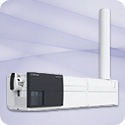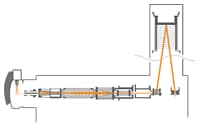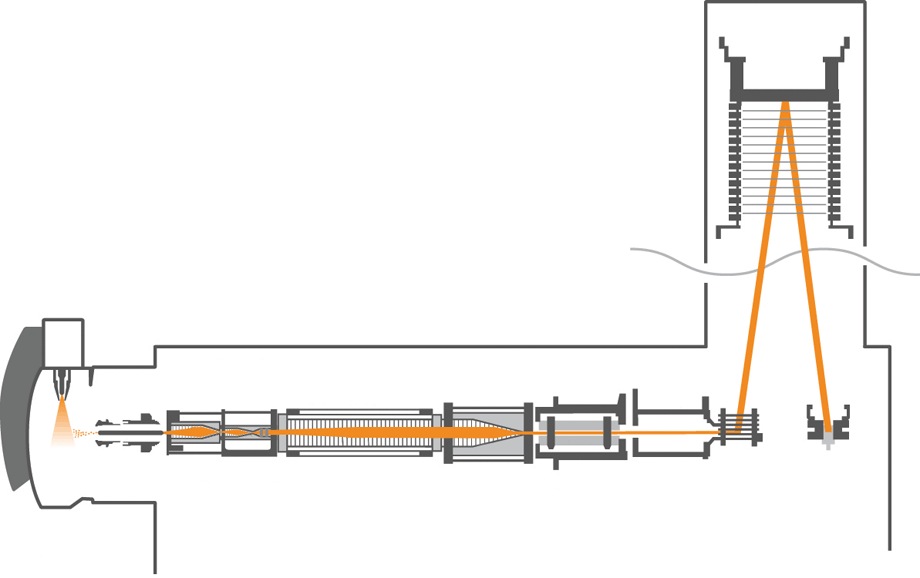Access Agilent eNewsletter, May 2014
>> Update My Profile | Subscribe to Access Agilent | Article Directory

Add a new dimension to your LC/MS Ion Mobility research
By Ken Imatani
Agilent QTOF LC/MS Product Manager
The Agilent 6560 Ion Mobility Quadrupole Time-of-Flight (IM-QTOF) Liquid Chromatography(LC)/Mass Spectrometry (MS) system is the first commercially available uniform field ion mobility (IM) system, which when coupled with the Agilent 1290 Infinity UHPLC System, provides the combined separation power and selectivity of LC, IM, and MS techniques.
Laboratories involved in cutting edge research can speed up research programs and have greater confidence in compound identification with the additional dimension of separation, as well as the structural information provided by ion mobility measurements. This instrument is the only commercially available drift ion mobility high resolution (both mobility and mass) LC/MS system which simultaneously provides high sensitivity and accurate collision cross section measurements.
Achieve greater analytical detail for complex samples
The Agilent 6560 IM Q-TOF system was developed with the collaboration of scientists from a number of academic institutions and government laboratories. In multiple studies, the instrument has demonstrated the ability to reveal significantly greater analytical detail for complex samples compared to high resolution mass spectrometry technology alone.
Researchers have reported that while high resolution mass spectrometry has become the analytical cornerstone for proteomics, metabolomics, and other research applications requiring the analysis of highly complex samples, there has also been significant interest in the use of ultra-fast orthogonal techniques to provide added dimensions of separation. This new ion mobility system can provide researchers with greater analytical detail for the following challenges:
Resolve Structural Isomers
- Probe the molecular structure and conformation of peptides and proteins using high-resolution ion mobility separation.
- Directly determine molecular size (from collision cross sections) without reference standards or calibration tables.
Increase Peak Capacity
- Effectively resolve individual components in complex mixtures with the combined power of UHPLC, ion mobility, and mass spectrometry.
- Obtain optimal ion mobility separation with double-grid trapping technology.
Find and Confirm Minor Components
- Readily detect low femtogram analytes in complex matrices using electrodynamic funnel technology.
- Confidently identify compounds using All Ions MS/MS.
Preserve Protein Conformations
- Easily study gas phase peptide and protein structures.
- Effectively minimize ion heating effects to maintain molecular conformations.
 Enlarge
Enlarge
Figure 1. Schematic of Agilent IM-QTOF coupled to a quadrupole time-of-flight mass spectrometer using a hexapole ion guide. The Q-TOF MS has a mass resolution of over 40,000 and five orders of magnitude dynamic range in Q-TOF mode of operation.
Higher quality MS/MS Spectra at trace levels
The Agilent 6560 IM Q-TOF system enables direct determination of collision cross section (CCS or Ω) measurements without calibration standards (Figure 1). It operates with uniform low field conditions, thus allowing the drift time information for ions to be used to determine collision cross section measurements. The innovative ion funnel technology in this instrument dramatically increases the ion sampling into the mass spectrometer and results in higher quality MS/MS spectra at trace levels. For more details on this technology read Agilent Technical Overview 5991-3244EN.
Agilent 6560 IM Q-TOF delivers significant gains in ion mobility performance
The Agilent IM-QTOF LC/MS system is a major advance in the commercial development of analytical ion mobility-mass spectrometry. Optimized development of a uniform drift field mobility cell and interface to a high resolution Q-TOF instrument gives a significant gain in ion mobility performance. The use of ion funnel technology pioneered by Agilent for both triple quadrupole and Q-TOF instruments over the past three years has been incorporated into the new IM-QTOF system. This has resulted in combined ion mobility separation and mass resolution with high sensitivity.
Recent work with several collaborators has confirmed that the instrument delivers:
- Greater separation of lipids and glyco-peptides
- More accurate collision cross section measurements enabling more confident characterization of structural conformations and isomeric compounds
- Greater numbers of trace level peptides in complex matrices
- Preservation of structural fidelity of metallo-proteins in liquid phase solutions
To maximize the analytical utility of this system, Agilent also developed software tools for data visualization of ion mobility data. Agilent LC/MS MassHunter Software is designed to allow researchers to interrogate mobility/mass domain data and easily determine collisional cross section values with high precision and accuracy.
Agilent offers a full range of LC/MS and GC/MS solutions
To discover more about the science and functionality of the Agilent 6560 Ion Mobility system, view this short animated video. Then take a moment to explore the full range of Agilent IM-QTOF LC/MS systems and Gas Chromatography (GC)/MS solutions.
>> Update My Profile | Subscribe to Access Agilent | Article Directory
